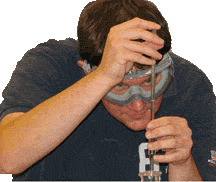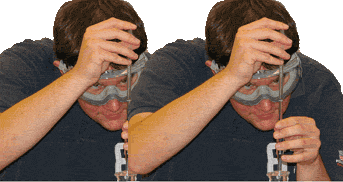How to scale back up
So far we’ve figured out how to make a dilution, which we can then plate and count. But this means we are only counting a fraction of what was originally there. How do we account for that? By scaling up.
"Scaling up" means starting from the number or concentration in a sample, and figuring out how many were in the original brew of coffee, or original sample of a chemical or a bacterial culture.
For example, we can start with a cup of weak coffee and figure out how much caffeine was in the original brew. All we need to know is what the overall dilution factor was. In the case of weak coffee, it was 1/50.
So, when we count the caffeine molecules in a cup of weak coffee, we know that we’ve got 1/50th of what was in a cup of the original brew -- or in other words, there was 50 times as much in a cup of the original. So we multiply the number we counted or measured by the inverse of the dilution – in this case, 50. This inverse of the dilution is called the dilution factor.
- If the dilution is in the form of a fraction,
you can "flip" the fraction
(i.e., 1/50 becomes multiply by 50/1). - If the dilution is written in scientific notation (eg 10-5)
you can make the exponent positive
(i.e., 10-5 becomes multiply by 105).
Finally, notice that I'm telling you the total number of caffeine molecules in ONE CUP of the original brew. If I don't know the actual amount of original brew, I won't know the total amount of caffeine that there was in the whole brew.
 Back to the lab
Back to the lab
Here are some problems, ranging from easy to a bit hard...
I did a series of dilutions with an overall dilution factor of 1/20,000, and then plated a 1mL sample. After 1 day, I counted 27 CFUs on the petri dish. How many CFUs would there be per 1mL of the original stock?
(To make this problem interactive, turn on javascript!)
- I need a hint ... :
inverse of 1/20,000 is 20,000 - ...another hint ... :
27*20,000 = ...
I think I have the answer:540,000 or 5.4 x 105 CFU per mL
 I did a series of dilutions, 1/10, 1/10, and 1/100. At the end I plated and grew a 1mL sample, and counted 48 CFUs. How many CFUs would there be per 1mL of the original stock?
I did a series of dilutions, 1/10, 1/10, and 1/100. At the end I plated and grew a 1mL sample, and counted 48 CFUs. How many CFUs would there be per 1mL of the original stock?
(To make this problem interactive, turn on javascript!)
- I need a hint ... :
What's the overall dilution factor? - ...another hint ... :
overall dilution factor = 1/10 * 1/10 * 1/100= 1/10000 - ...another hint ... :
Multiply by the inverse...
I think I have the answer: 48 * 10000 = 480,000 or 4.8 x 105 CFUs per mL
 I did a series of dilutions as follows:
I did a series of dilutions as follows:
*1 mL added to 9 mL water
*1 mL added to 99 mL water
*1 mL added to 49 mL water
If the final 1mL sample had 152 colonies, what was the original concentration?
(To make this problem interactive, turn on javascript!)
- I need a hint ... :
The dilution factors were 1/10, 1/100, and 1/50 - ...another hint ... :
The overall dilution was 1/50,000
I think I have the answer:152 * 50,000 = 7,600,000 or 7.6 x 106 cfus/mL
Copyright University of Maryland, 2007
You may link to this site for educational purposes.
Please do not copy without permission
requests/questions/feedback email: mathbench@umd.edu